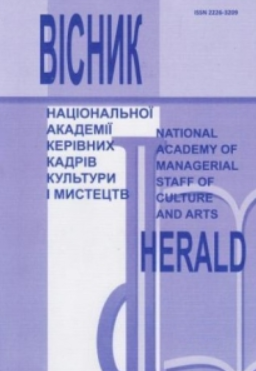ІДИЛІЧНІ СЮЖЕТИ У ТВОРЕННІ НАРАТИВІВ МОДЕРНИХ НАЦІЙ НА ПРИКЛАДІ НІМЕЦЬКОГО, ЄВРЕЙСЬКОГО ТА УКРАЇНСЬКОГО ЖИВОПИСУ
IDYLLIC STORY IN THE CREATION OF MODERN NATIONS NARRATIVES, ON THE EXAMPLE OF GERMAN, JEWISH AND UKRAINIAN PAINTING
Author(s): Roman Frankiv, Khrystyna BoykoSubject(s): Cultural history, Visual Arts, History of Art
Published by: Національна академія керівних кадрів культури і мистецтв
Summary/Abstract: The purpose of the article is to identify the features of idyllic artistic plots related to German, Jewish and Ukrainian national narrative. Try to evaluate their motivating mechanism. The methodology is the use of ideological and plot analysis, methods of comparison and generalization. The scientific novelty is to expand the understanding of the plot content of some works of German, Jewish and Ukrainian art, in the context of their nation - creative motivation. Conclusions. The period of creation of modern nations became a great challenge for art. An important motivating role belongs to the creation of the image of the "ideal being", the mandate to which the new community promised. Thus, the nation-creative plot is, in one way or another, connected with sacralization sentiments. German painting in the Romantic era operated with paintings of idyll, which, however, contains memories of the Middle Ages as an era of even greater perfection. Thus arose the motivating potential of "return" to the epic of the past. Jewish art culture is characterized by a tradition of associating the ideal being with the holy city of Jerusalem, a "return" to which also has motivating potential. In Ukrainian art, there are also plots of natural idyll, but the situation of "ideal existence" is connected with the inner state of man - the warrior "Cossack Mamaу", who gains personal freedom for creativity. As a result of the study, it was found that idyllic plots associated with the creation of modern national narratives in German, Jewish and Ukrainian painting have a number of common and distinctive features. Common features include the presence of sacred content and solidarity of the surrounding community. Distinctive features are different vector of orientation of the motivating plot. In art related to the German narrative of ideal nation existence, vector can be described as epoch-centric, with the Jewish narrative as city-centric, and with Ukrainian as anthropocentric.
Journal: Вісник Національної академії керівних кадрів культури і мистецтв
- Issue Year: 2021
- Issue No: 2
- Page Range: 159-164
- Page Count: 6
- Language: Ukrainian

